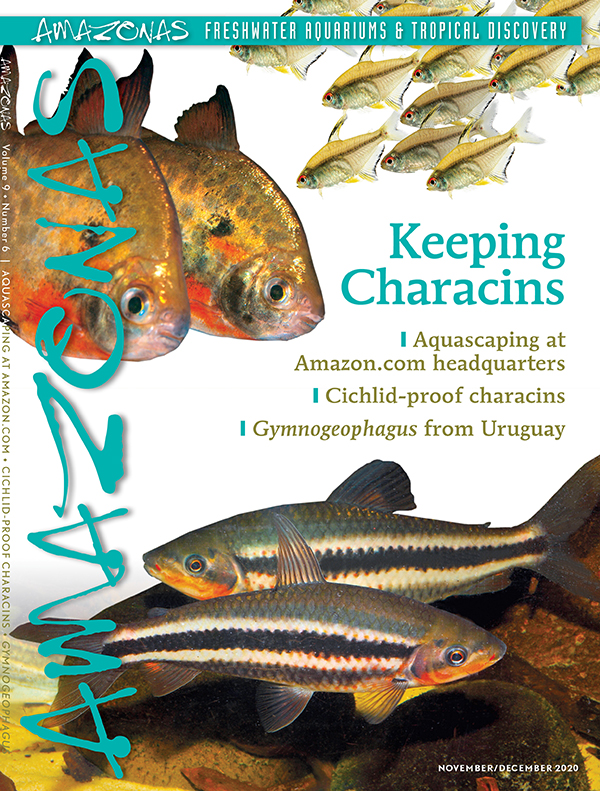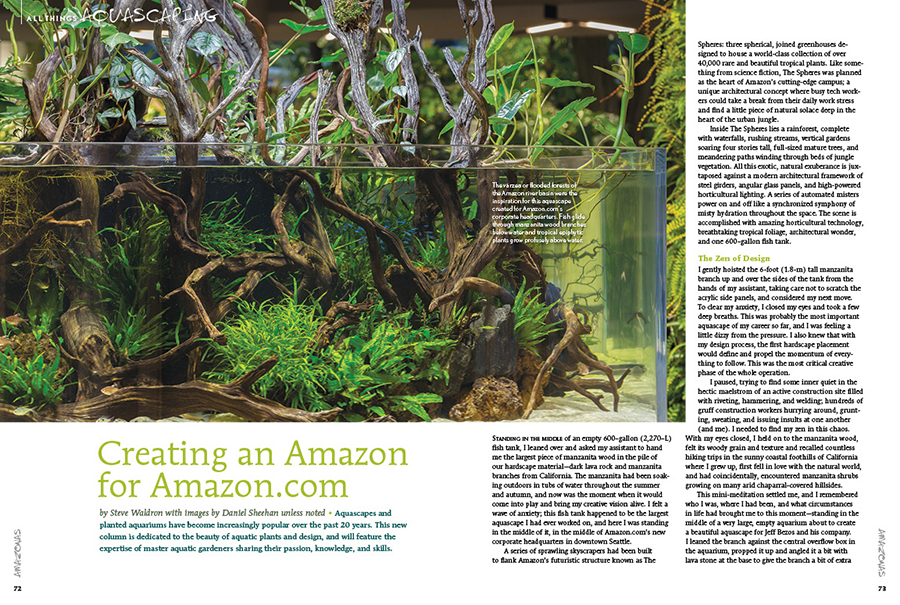
A partial excerpt from the November/December 2020 issue of AMAZONAS Magazine. Subscribers can log in to the digital edition for full access.
by Steve Waldron with images by Daniel Sheehan unless noted • Aquascapes and planted aquariums have become increasingly popular over the past 20 years. This new column, All Things Aquascaping, is dedicated to the beauty of aquatic plants and design, and will feature the expertise of master aquatic gardeners sharing their passion, knowledge, and skills.
Standing in the middle of an empty 600–gallon (2,270–L) fish tank, I leaned over and asked my assistant to hand me the largest piece of manzanita wood in the pile of our hardscape material—dark lava rock and manzanita branches from California. The manzanita had been soaking outdoors in tubs of water throughout the summer and autumn, and now was the moment when it would come into play and bring my creative vision alive. I felt a wave of anxiety; this fish tank happened to be the largest aquascape I had ever worked on, and here I was standing in the middle of it, in the middle of Amazon.com’s new corporate headquarters in downtown Seattle.
A series of sprawling skyscrapers had been built to flank Amazon’s futuristic structure known as The Spheres: three spherical, joined greenhouses designed to house a world-class collection of over 40,000 rare and beautiful tropical plants. Like something from science fiction, The Spheres was planned as the heart of Amazon’s cutting-edge campus; a unique architectural concept where busy tech workers could take a break from their daily work stress and find a little piece of natural solace deep in the heart of the urban jungle.
Inside The Spheres lies a rainforest, complete with waterfalls, rushing streams, vertical gardens soaring four stories tall, full-sized mature trees, and meandering paths winding through beds of jungle vegetation. All this exotic, natural exuberance is juxtaposed against a modern architectural framework of steel girders, angular glass panels, and high-powered horticultural lighting. A series of automated misters power on and off like a synchronized symphony of misty hydration throughout the space. The scene is accomplished with amazing horticultural technology, breathtaking tropical foliage, architectural wonder, and one 600–gallon fish tank.
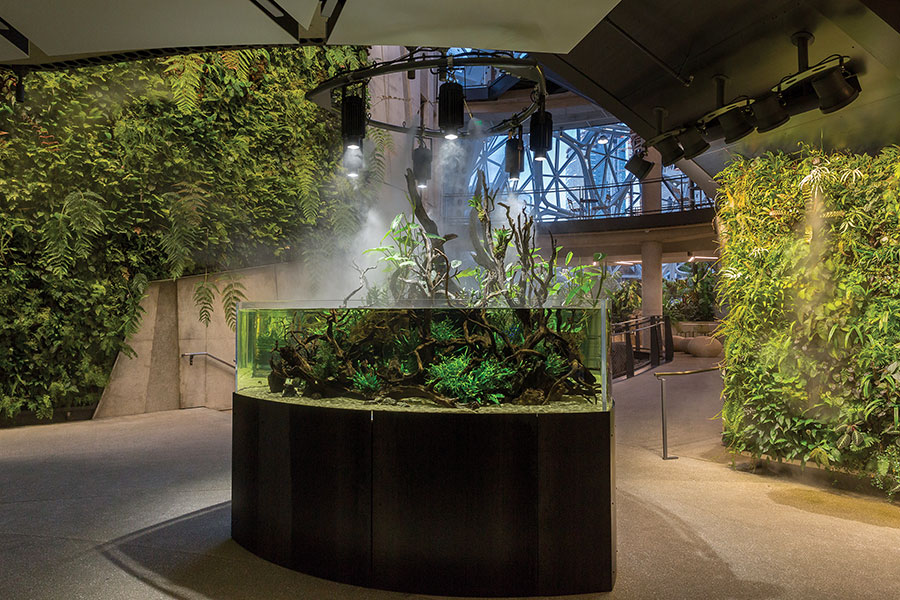
The Zen of Design
I gently hoisted the 6-foot (1.8-m) tall manzanita branch up and over the sides of the tank from the hands of my assistant, taking care not to scratch the acrylic side panels, and considered my next move. To clear my anxiety, I closed my eyes and took a few deep breaths. This was probably the most important aquascape of my career so far, and I was feeling a little dizzy from the pressure. I also knew that with my design process, the first hardscape placement would define and propel the momentum of everything to follow. This was the most critical creative phase of the whole operation.
I paused, trying to find some inner quiet in the hectic maelstrom of an active construction site filled with riveting, hammering, and welding; hundreds of gruff construction workers hurrying around, grunting, sweating, and issuing insults at one another (and me). I needed to find my zen in this chaos. With my eyes closed, I held on to the manzanita wood, felt its woody grain and texture and recalled countless hiking trips in the sunny coastal foothills of California where I grew up, first fell in love with the natural world, and had coincidentally, encountered manzanita shrubs growing on many arid chaparral-covered hillsides.
This mini-meditation settled me, and I remembered who I was, where I had been, and what circumstances in life had brought me to this moment—standing in the middle of a very large, empty aquarium about to create a beautiful aquascape for Jeff Bezos and his company. I leaned the branch against the central overflow box in the aquarium, propped it up and angled it a bit with lava stone at the base to give the branch a bit of extra dramatic vertical presence, and my creative process started to flow from there.
Materials and Methods
The aquarium system itself was built and designed by Tenji Aquarium Design + Build of Carmel, California, and in collaboration with the global architectural design firm, NBBJ. At 600 gallons, 30 inches (76 cm) tall and 102 inches (260 cm) wide, the aquarium was constructed of thick acrylic and shaped as a Reuleaux triangle—the geometric form at the center of three intersecting disks. It’s basically a triangle with rounded sides and when viewed from above, looks very similar to a guitar pick. This was my blank canvas to create a peaceful aquatic paradise of swaying plants, shoaling fishes, and artfully arranged natural wood and stone decor.
This was going to be a low tech, non-CO2 injected aquarium with as much emphasis on a large and diverse fish community as the planted aquascape itself. To that end, Tenji designed a below-tank sump filtration system consisting of a series of bag filters and a single large biofilter chamber filled with perpetually swirling plastic biomedia. A pair of jacuzzi pumps would quietly and amply circulate the water, and a UV filter would prevent green water and pathogens outbreaks. The whole system was connected to an Apex controller, allowing for remote monitoring and automated control.
An array of six Ecoxotic Cannon LED pendant lights were hung above the aquarium from a custom-built fixture that matched the Reuleaux triangle shape of the aquarium below. I wanted pendant, single-point-source lighting for this aquarium to create a dynamic light effect—shimmering glimmer lines that would bring in the kinetic energy of scattered light movement to this display. This type of lighting was a key feature to the aquascape’s presentation and success. I figured the aquarium could function as an exhibit of moving aqueous light energy that would complement the relatively static world of The Spheres’ collection of plants and architecture. The dancing quality of light would act as a sort of beacon to draw in viewers to the aquarium from various parts of The Spheres. Once the viewer was up close, standing in front of the aquarium, they would then start to explore and make discoveries about the living inhabitants and details of the aquascape itself.
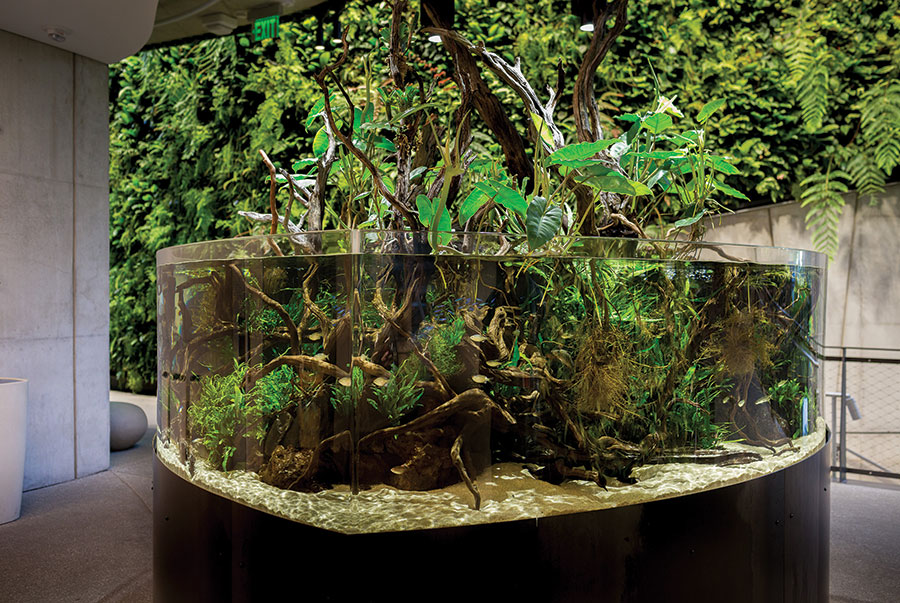
Amazon-Themed Community
I chose an Amazon theme for The Spheres’ fish community. There’s the obvious connection to Amazon.com’s brand, but that was peripheral to my decision-making process. I chose Amazonian fishes simply because, in terms of diversity, beauty, personality, economy, and availability, it is hard to match this group when considering fish selections for a large community tank. In my opinion, fish that have co-evolved in the same natural habitats tend to blend more harmoniously with one another and create more impact than a haphazard menagerie of species thrown together from all over the globe. I wanted movement, color, and curiosity. I wanted tiny fish, giant fish, elegant fish, large schools, and goofy oddballs—I wanted a diverse slice of the legendary Amazonian fish fauna.
There are no 90-degree angles to this aquarium, and the fish move constantly in a flowing circumambulation around the rounded sides of the Reuleaux. A school of over two hundred green neon tetras (Paracheirodon simulans) shoal with smaller schools of diamond tetras (Moenkhausia pittieri), red and black phantom tetras (Hyphessobrycon sweglesi and H. megalopterus, respectively), rosy tetras (H. rosaceus), and other characins.
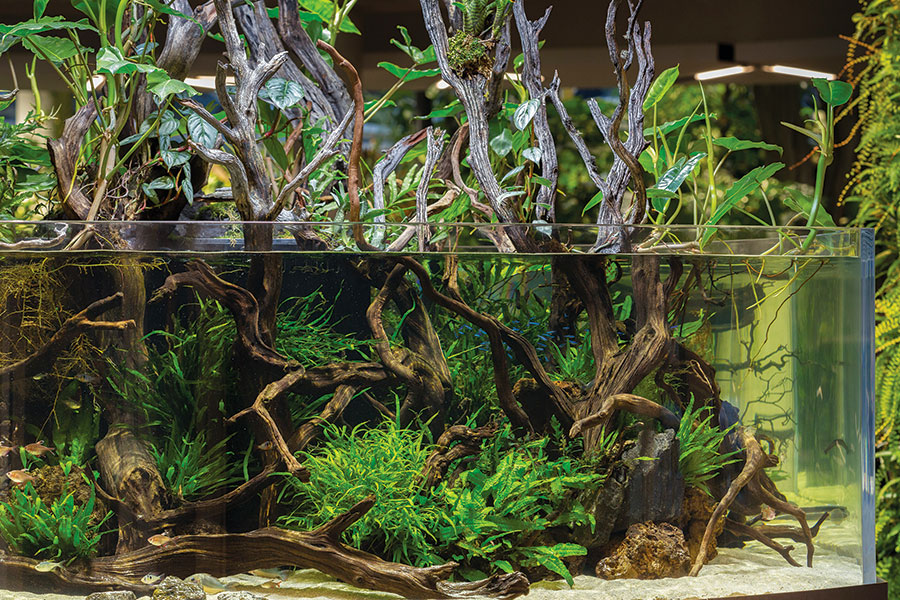
Want more?
What other fishes dwell in AMAZON.com’s Amazon? What plants did Waldron opt to use, and how were they incorporated into the functional system. How did this project all come together, and how was it received? Just want to see more incredible images of this amazing planted aquarium?
You’ll find it all in the November/December 2020 issue of AMAZONAS Magazine. It’s on sale now at some of the best aquarium stores. Many subscribers have the printed issue delivered to their mailbox, and all current subscribers can read this article in the digital archive. You can also order a single copy printed back issue and have it delivered to your door.
If you want access to the full story, and years of back issues, subscribe to AMAZONAS Magazine today. Digital edition access is instantaneous with your paid subscription!
About The Project
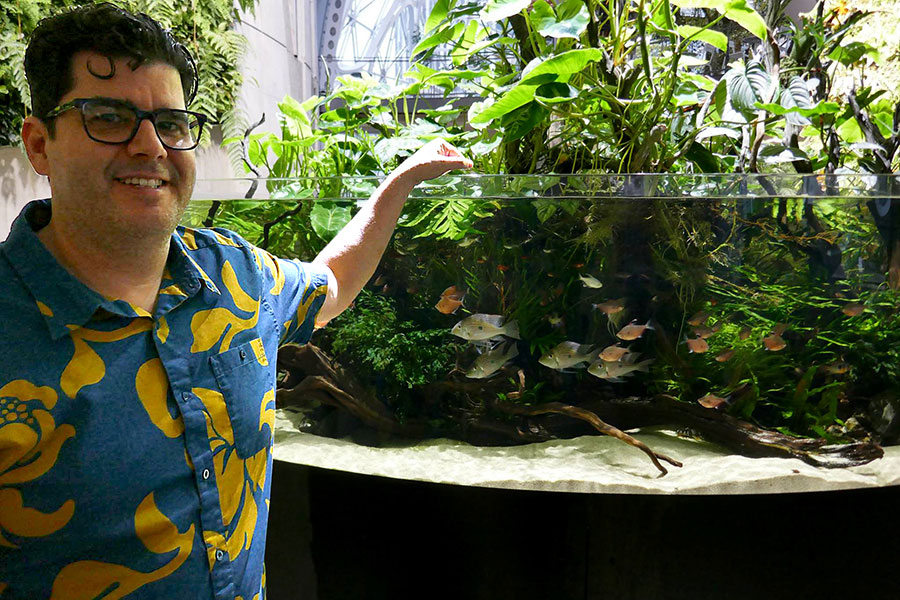
Steve Waldron is the founder of Seattle-based Aquarium Zen, a retail aquarium shop specializing in freshwater Nature Aquarium design. Aquarium Zen’s website is www.aquariumzen.net and Steve can be found on Instagram @aquariumzen.
Photographer Daniel Sheehan specializes in photojournalism, editorial portraits, corporate portraits and corporate event photography. He is based in Seattle, WA. More at www.eyeshotphotos.com.
Tenji Inc. is a commercial member of the Association of Zoos & Aquariums (AZA), specializing in the design, fabrication and installation of commercial-scale aquariums for public aquariums, commercial spaces, and large-scale private installations. Tenji is based in Carmel, CA, with an additional East Coast office in Newcastle, Maine. More at www.tenji.com.
First conceived in February, 2013, Amazon.com’s Seattle Spheres were officially opened in January, 2018, situated at Amazon.com headquarters in downtown Seattle, Washington. While currently closed to the public due to the COVID-19 pandemic, public tours are ordinarily available on select weekends. Learn more at www.SeattleSpheres.com.

